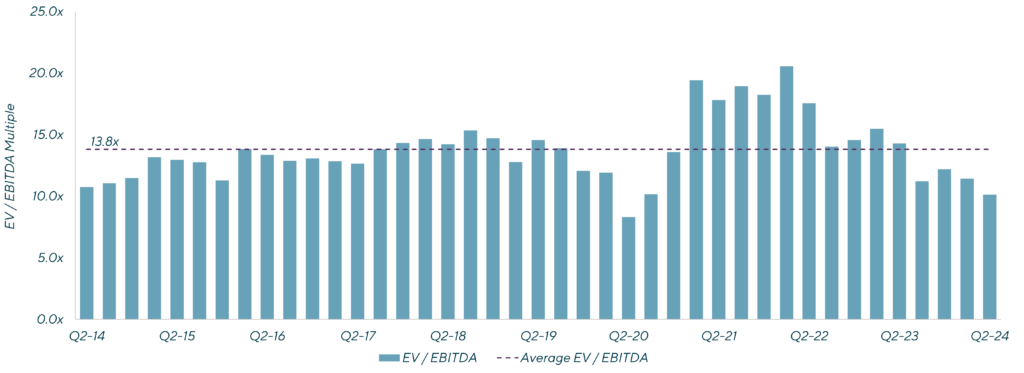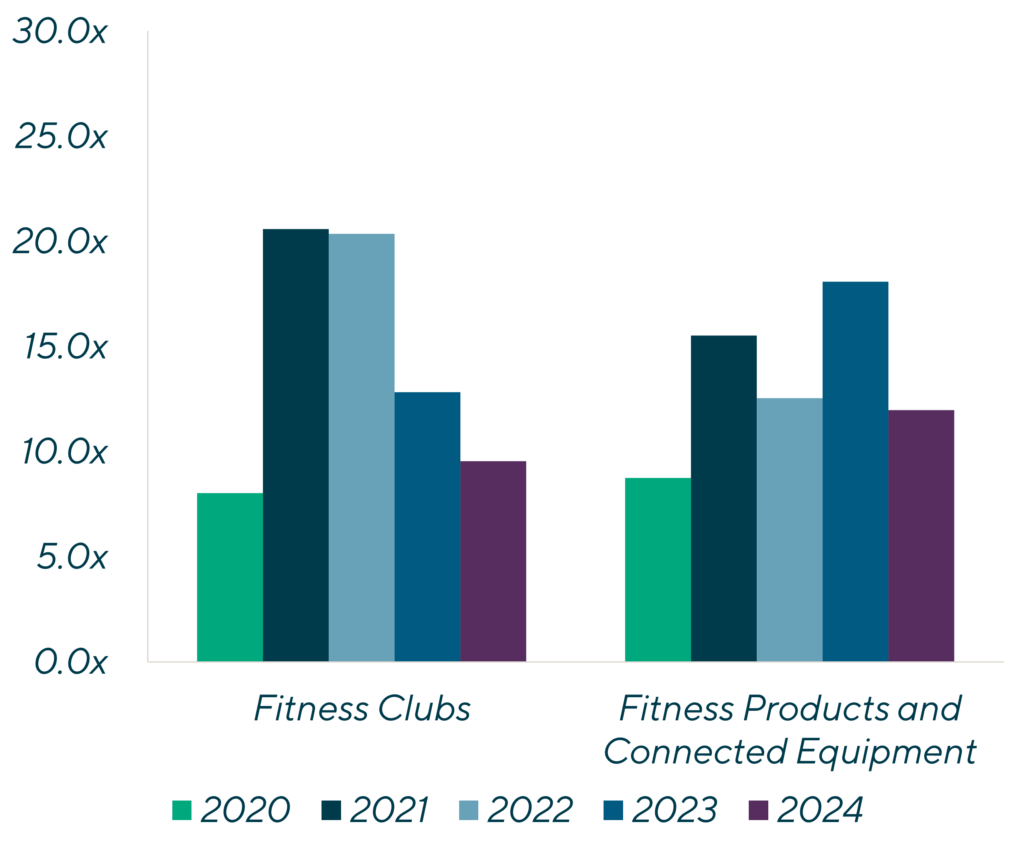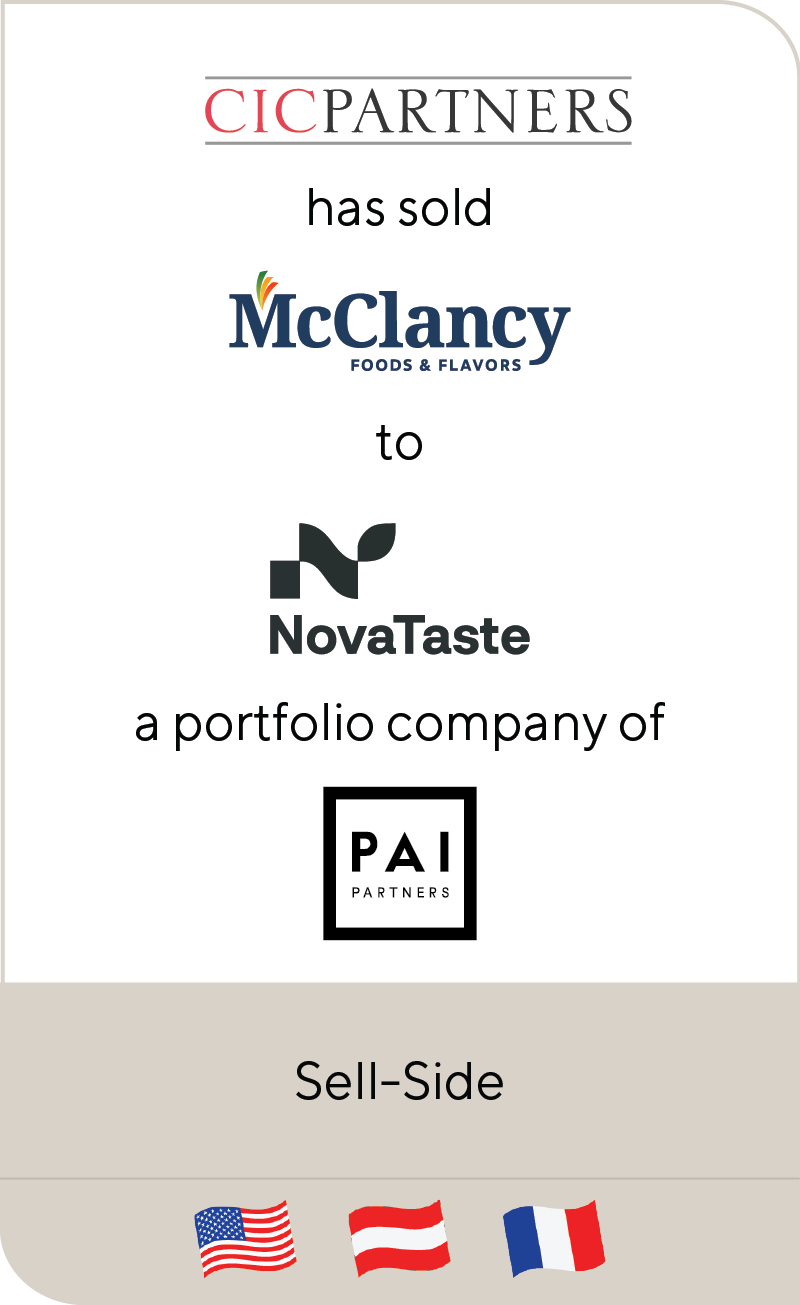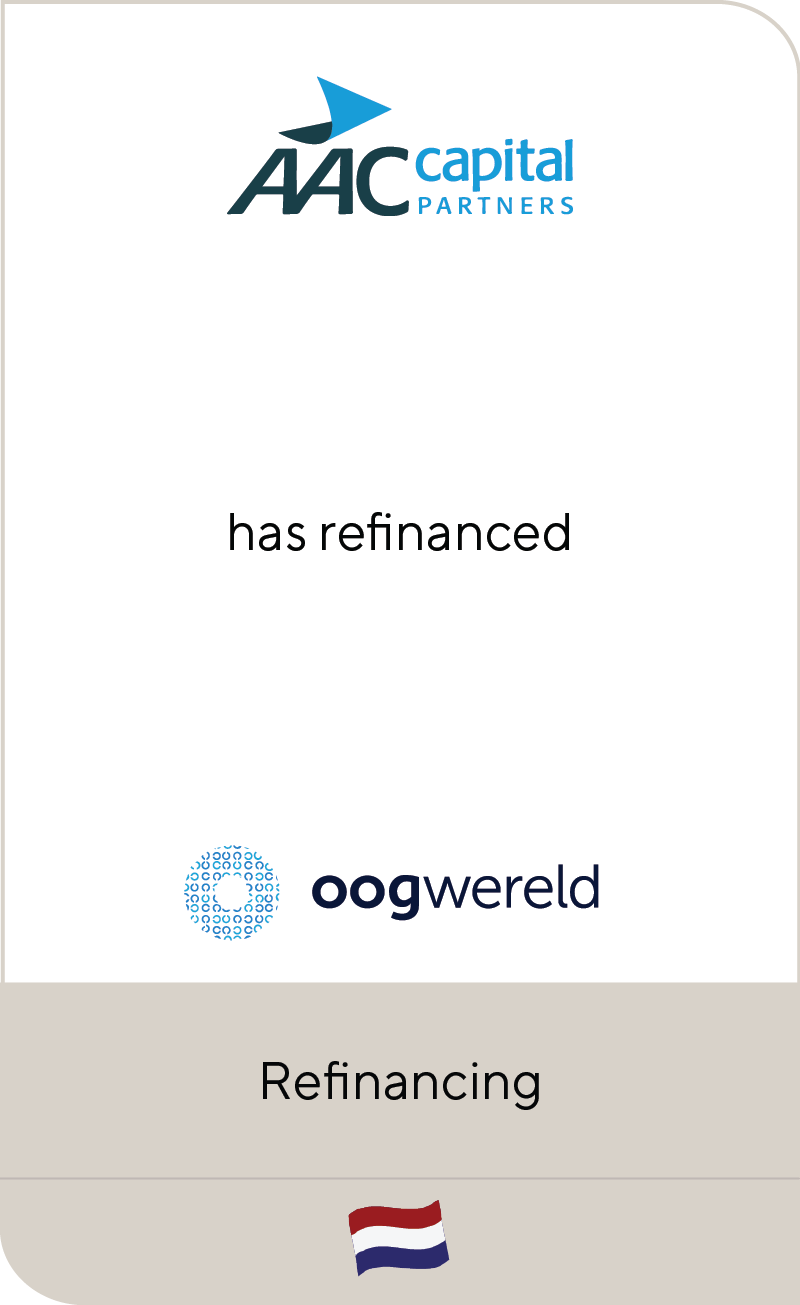The Fitness Investment Landscape
May 2024
State of the Fitness Market: presented by L.E.K. Consulting
Fitness Market Stabilization and Return to Growth
Few industries were as negatively impacted by COVID-19 as the in-person fitness industry. Deemed “non-essential” businesses, gyms were forced to close their doors for an extended period of time and endure a cautious, phased approach to re-opening that varied significantly based on geography and changing public health guidelines. As a result of the challenging operating environment, many gyms closed permanently. In fact, the number of U.S. gym locations decreased by ~25% from 2019 to 2022, with the long tail of independent gyms disproportionately affected.
Summary
-
Advisors from Lincoln International and L.E.K. Consulting explore select key M&A investor themes as well as the state of the fitness market.
- Click here to download a printable version of this report.
- Sign up to receive Lincoln's perspectives
Coupled with the proliferation of digital fitness solutions, many industry headlines questioned if in-person fitness would ever return to its pre-COVID heights.
However, over the past 18 months, the narrative surrounding in person fitness has dramatically reversed as consumers have increasingly opted to return to in person fitness activities. While the broader market remained below pre-COVID levels in 2023, the industry has been resilient despite ongoing inflationary pressures and recessionary concerns, and regained its growth momentum, as total membership grew to ~73M members in 2023 (up ~6% vs. 2022) and member visits reached ~5.8B (up ~11% vs. 2022).
HVLP and Premium Gym Segments Leading the Way
Though a rising tide has lifted all boats, High-Value Low-Price (HVLP) gyms (e.g., Planet Fitness, Crunch Fitness) and Premium gyms (e.g., Life Time, Equinox) have outpaced the broader market and continued to capture share from the mid-market segment, albeit for different reasons.
HVLP gyms are attracting consumers with a straightforward pricing model that includes an affordable entry price (typically ~$10 / month) and a premium membership tier with access to a broader suite of amenities (typically ~$25 – $40 / month). The low entry price is appealing to a wide range of consumers, particularly Gen Z. Additionally, HVLP gyms have benefitted from the sharp decrease in gym locations during COVID as they have been able to capture displaced members and backfill the gap with new locations. As a result, Planet Fitness (+27%) and Crunch Fitness (+81%) saw a materially higher number of total visits in Q4 2023 compared to Q4 2019, while LA Fitness (-18%) and 24 Hour Fitness (-7%) experienced a decline in overall visits.
Change in Visits to Leading Fitness Chains (Q4 2023 vs. Q4 2019) Source: Placer.ai (https://www.placer.ai/blog/focusing-on-fitness-q4-and-january-recap) |
While the HVLP segment is a member growth story, the Premium segment is driving growth by increasing revenue per member. Despite opening an additional ~20 centers over the past 3 years, Life Time’s member count at the end of 2023 was ~5% below its 2019 level. However, its revenue was up ~17% overall, as its revenue per member increased from ~$2.2K to $2.7K.
| Life Time Fitness Revenue and Membership (EOY 2019 vs. EOY 2023) |
Favorable Tailwinds Will Continue to Drive Growth
Though average visits per member remain much lower than pre-COVID levels (79 visits in 2023 vs. 109 visits in 2019, a 28% decline), there are several trends that suggest there is still substantial upside for in-person fitness.
First, according to a recent L.E.K. Consulting survey of Health & Wellness consumers, ~75% of gym members report a relatively high level of satisfaction with their current membership and believe the membership provides strong value for money.
This buffer helps gyms maintain strong membership levels, even if gym engagement lags pre-COVID levels.
Second, strength training is experiencing rapid growth in interest as more consumers become aware of the short-term and long-term benefits, including improved muscle & bone mass, decreased anxiety and stress, and reduced disease & mortality. According to Google Trends, searches for “strength training” were ~40% higher in 2023-24 compared to 2019-21. Strength training has expanded beyond the typical audience, as women and Gen Z consumers are increasingly incorporating strength training into their routines. Gyms benefit from a stronger appeal to a wider consumer base and provide access to a robust set of weights and strength training equipment that is much harder and more expensive to replicate at home than a piece of cardio equipment.
Finally, the explosive growth of Glucagon-Like Peptide-1s (GLP-1) should act as a major tailwind for gyms. While some may question the value of a gym membership when GLP-1s effectively act as a ‘silver bullet’ for weight loss, strength training is critical to preserving lean muscle mass amidst rapid weight loss facilitated by these drugs and is increasingly recommended by administering healthcare professionals. This may actually increase the addressable membership base for gyms, as it enables consumers whose weight and body image would have otherwise prevented them from even considering a gym membership. These emerging dynamics also create new revenue opportunities for gyms, such as specialized fitness programs tailored for GLP-1 users or a holistic health program that combines GLP-1s with personalized fitness programs (e.g., Life Time and Miora).
Navigating the M&A Landscape in the Fitness Industry:
A Strategic Outlook: presented by Lincoln International
| Throughout the 2024 IHRSA trade show in Los Angeles, there was a clear revelation (almost a sigh of relief) that investors and industry executives are, finally, starting to focus on trends and metrics relative to year-over-year performance rather than utilizing pre-COVID benchmarking. This change in perspective has perpetuated itself into the investor mindset and is impacting the M&A landscape of the fitness industry. Fitness clubs and fitness product companies are now being evaluated for their ability to retain and/or capture consumer demand and grow in today’s environment with minimal consideration of what these companies did 5-10 years ago. As the fitness sector matures in this “new normal” environment, Lincoln International explores select key M&A investor themes the sector is experiencing in 2024. |
KEY M&A INVESTOR THEMES
Investors are Still Bullish on HVLP and HVLP 2.0 Concepts
HVLP concepts have (for the most part) rebounded nicely since 2020 and continue to command strong unit economics and growing consumer participation rates. The HVLP value creation thesis of consolidating smaller players within a given ecosystem with the goal of selling the broader platform at a higher valuation still holds water. As such, investors continue gravitating to this part of the sector in droves, which has supported healthy valuations throughout the category (albeit not to the same levels as 2021-22 – more about that below). That said, this stability in the HVLP subsector comes with caveats as investors are focused on specific nuances within each ecosystem. For Planet Fitness (PF) systems, the investor landscape is focused on (outside of the constant noise at the franchisor level related to an unexpected CEO departure, a CFO departure and a questionable public relations department) market maturity and ability to increase units given the perceived saturation across the U.S. landscape. For Crunch Fitness, the investor landscape is optimistic that this ecosystem represents what PF was 10-15 years ago and is keen to see what near-term exits yield in terms of valuation benchmarks. These systems are here for the long haul and investors who are willing to dive into sophisticated market mapping will likely continue to find ways to generate value for their LPs in this segment of the fitness landscape.
Shareholders of Lower Middle Market Fitness Companies have “Done their Time” and are Ready for Liquidity
Being the owner of a fitness concept (whether a 5-10-unit Planet Fitness franchisee or a differentiated fitness product manufacturer) during the COVID years was a demanding and taxing experience. These operators and shareholders believe they have paid their dues and are starting to look for an exit in the near term. Many of these companies have already traded hands in the past 6-12 months with valuations remaining stable across the board. A key consideration to factor into a seller’s timing decision is whether valuation compression (e.g., quarter/half a turn for smaller HVLP concepts) will occur if several concepts hit the market at the same time.
Investors are Trying to Figure out Which Boutique Concept is Viable in the Long Run
While historically stable HVLP gyms dominate the investor landscape, high growth boutique fitness studios have carved out their niche.
These specialized centers offer tailored experiences, personalized training and a sense of community. From boxing to hot yoga, boutique fitness appeals to discerning consumers seeking unique workouts. However, investors face a conundrum: which boutique concepts will thrive in the long term? As the market evolves, distinguishing sustainable models from fads remains a challenge. There are two to three clear winners in this category while others are still trying to find their footing in a post-COVID world. As we go through 2024, it will likely become clear if differentiated boutique concepts still command a premium multiple.
Outlier Valuations are Largely in the Rear View Mirror with Valuations Holding Steady for Larger Platforms
In 2021 and 2022, there were several high-profile transactions which resulted in outlier valuations relative to historical norms. These generally occurred within select HVLP ecosystems or smaller high-growth franchisee systems which were experiencing a quick bounce back to pre-COVID levels. As the flurry of M&A deals progressed in 2022 and into 2023, valuations returned to normalized levels and are widely anticipated to remain back to historical norms for larger platforms and smaller tuck-ins (albeit to varying degrees for each specific system). The primary question that continues to perpetuate itself across all four-wall fitness concepts: what EBITDA metric is the valuation multiple based off of?
Fitness Product Companies with a Diversified Channel Mix, Strong Balance Sheet and Active M&A Pipeline Will Likely Generate Outsized Value Creation Relative to their Peers
In 2020 and early 2021, consumers built up their garage or spare room gyms en masse. As work-from-home regulations ended and supply chain dynamics resolved in the industry, there was a clear signal to the fitness product market that demand was leveling off at the same time supply was finally unrestrained. These trends were made public through Peloton’s stock price and have rippled throughout the fitness products ecosystem. As we look ahead to 2024 and 2025, there will likely be a focus on channel diversification (e.g., consumer focused brands leaning into commercial opportunities) along with continued consolidation in the sector as companies with strong balance sheets continue to add brands within their portfolio umbrellas.
Fitness Concept Tie-Ups Are Becoming Increasingly More Common
At IHRSA 2024, there was one common question: what is driving the proliferation of fitness tie-ups?
In most cases, the answer is a bit anticlimactic: it depends. There are varying specific reasons why Orangetheory Fitness / Self Esteem Brands merged in April 2024 while certain concepts are continually adding brands to their portfolio – think Lift Brands (Snap, Fitness On, 9Round, Fitstop), Xponential Fitness (portfolio of 10 brands) and RSG Group (Gold’s, McFIT, HEIMAT, JOHN REED). Without getting into the nuances of each holding company’s strategy, the common theme connecting these brand umbrellas relates to the goal of diversifying boutique concept risk. Boutique fitness clubs have the ability to drive significant growth by capitalizing on new consumer fitness trends but must manage through dynamics of potential fad risk or changing consumer preferences (something that Crunch Fitness, Planet Fitness and Life Time Fitness do not worry about as much). As such, investors diversify their specific boutique concept risk by matching these concepts with other brands with the goal of smoothing out the financial profile of the holding company. As investors seek liquidity from underperforming concepts, larger fitness portfolios have a clear opportunity to continue expanding their brand network.
Shelved M&A Processes from Early 2020 are Coming Back Out to Market
There were several prolific fitness related M&A processes put on hold in March-April 2020. The investor landscape, which generally relies on market stability and clear growth plans as the foundation of their interest, made it clear that any fitness-related deals were going to have to wait until the “new normal” was established. These specific companies turned their attention toward recovering from the industry downturn and proving their go-forward growth targets. While many of these companies remain on the sidelines, several are currently out, or will be out imminently, of the market. Time will tell if these processes yield the outcomes that were originally envisioned back in 2020.
THE M&A TAKEAWAY
While the M&A fitness landscape continues to be dynamic and multifaceted with varying trends within each subsegment, the industry will likely continue to see a heightened level of M&A activity (albeit not to the volumes and valuation levels of 2021-22). From a fitness club perspective, HVLP concepts will continue to consolidate their ecosystems and ultimately trade hands to an ever-evolving buyer landscape while boutique concepts will test investor appetite with varying degrees of success. For fitness product manufacturers navigating the broader consumer discretionary landscape, companies that have a clear multi-channel strategy, distinct product differentiation and healthy balance sheet will thrive in this “new normal” environment. Ultimately, investor appetite remains strong relative to other consumer categories which should drive a robust M&A environment for the foreseeable future.
Contributors

Through honest advice, passionate client service and hands-on execution, I strive to deliver outlier results for my clients.
Christopher Petrossian
Managing Director & Co-head of Consumer
Los AngelesMeet Professionals with Complementary Expertise in Consumer

I have a hands-on approach and bring energy, creativity and passion to every client transaction.
Eddie Krule
Managing Director
Chicago
I design strategies and offer solutions that fit the unique ambitions of each client I serve.
Brian Little
Managing Director
Los Angeles
I take a long-term approach to building relationships and understanding clients' businesses in order to provide timely and relevant advice.
Alex Masters
Managing Director & Co-head of Consumer, Europe
London




























